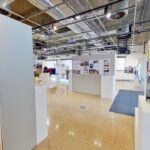String craft is the foundational basis of the exhibition. Both the Aboriginal DILLY BAG and the Papua New Guinean (PNG) BILUM are traditionally made from hand twisted plant fibres, and sometimes animal fibres, reflecting their connection to country. Today yarns are drawn from a broad range of sources including the recycling of materials. Apart from their utilitarian uses, the bilum and dilly bag have immense cultural importance and are stand-out examples of indigenous material culture. They are made almost exclusively by women, whose manufacture dates back well before European contact. In PNG and Australia, the use and cultural value of string bags is changing as they become items produced for sale and for the fashion and art world. These changes can be seen in some of the contemporary artworks on display. String Craft: Bilum + Dilly Bags offered audiences an opportunity to explore the intercultural connections found in aspects of string making and weaving techniques applied to the dilly bag and bilum. The exhibition celebrated the skill, innovation and creative expression engendered in the making of string bags. The exhibition was supported by the 2024 Indian Ocean Craft Triennial (IOTA24) for its significance to the presentation of these forms and their relationship to the examination of contemporary craft practices from around the Indian Ocean Rim.
Exhibitors
String craft features dilly-bag inspired art installations by leading First Nations WA artists Lea Taylor and Katie West. These works sit alongside a selection of dilly bags and textile artworks from Northern Territory artists from Bula’Bula Arts, Ramingining and Bábbarra Women’s Centre, Maningrida Arts & Culture, Maningrida. The bilums on display come from private collections, representing bilums from the Sepik, Highlands and coastal areas of PNG. They cover a range of traditional and contemporary bilum styles, patterns and fibres, typically found across the culturally and linguistically diverse country of PNG. Together the bilum and dilly bag artforms represented nearly 100 works highlighting the enormous diversity of indigenous cultural and craft practices across these regions.
Curators
Gina Koczberski is a Geographer and Senior Research Fellow at Curtin University, Perth Western Australia. She has over 35 years of research and fieldwork experience in PNG, working largely at the household level to examine agricultural change, smallholder commodity crop production, gender, migration and land.
Dr Anne Farren. Is an independent curator, arts educator and maker with 50 years experience in the visual arts, craft and design. She has coordinated multiple interdisciplinary projects and curated exhibitions that have toured both nationally and internationally.



